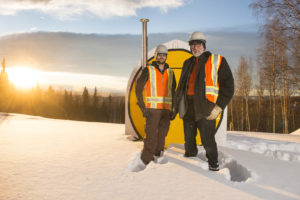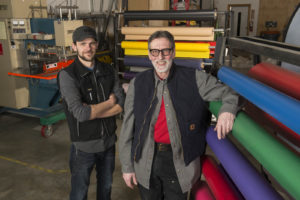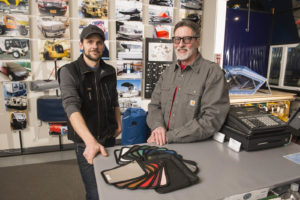
Eric Walton and Devlin Mckee bring fabric solutions to Alaska’s wild and wondrous terrain.
“The remote area where we work can be a challenge so we have to be flexible and willing to do lots of different things,” say Eric Walton, MFC, and Devlin McKee, CC, owners of Custom Canvas Alaska (CCA) in Fairbanks, Alaska. “People come to us with lots of different problems and we solve them with fabric and framework.”
Walton and McKee both worked for another local canvas company when, near the end of 2004, they decided to branch out on their own. “We felt like Fairbanks was large enough to support two canvas companies, so we met with our boss and spoke candidly about our plans,” Walton says. “Running the risk of being fired on the spot, we gave three months’ notice. After those three months, we parted ways on friendly terms and opened Custom Canvas Alaska in January 2005.”
Initially the company consisted of only Walton and McKee, and manufactured primarily boat tops and the occasional awning. Now it has four additional employees in the winter and six in the summer, and in addition to boat canvas and awnings, manufactures side curtains for ATVs, seat recovers for snowmobiles, products for industrial oil field vehicles, snow flies, shade sails and single-person shelters, among other things.
 A little help from your friends
A little help from your friends
Walton and McKee credit much of their company’s growth to Meini and Anna Huser, owners of Alaska Dreams Inc.—a company that sells and erects tensioned membrane fabric structures. CCA currently rents space from Alaska Dreams, but the company’s support goes much further than that.
Several years ago when a pre-owned 15k Thermatron RF welder came up for sale, Walton and McKee realized purchasing it would enable them to expand their product offerings, but at that time they were unable to make the investment. “I ran the opportunity by Meini and before I knew it the machine was being delivered—and he has loaned us that machine ever since,” Walton says. “We consider Alaska Dreams to be our mentor and guardian. They have been instrumental in our success.”
Having the welder has enabled CCA to manufacture replacement panels for Alaska Dreams in a short turnaround time, as well as provide Walton and McKee access to the industrial oil field market. CCA makes products used for vehicles in the oil fields—critical components to protecting the tundra, the most common of which are belly tarps. “Up on the slope they’re really, really conscious about anything dripping onto the tundra,” Walton says. “The tarps are made of oil-resistant low-temperature vinyl and are essentially diapers that tie underneath vehicles to catch anything that drips.”
An educated/informed consumer is our best customer. An educated/informed employee is our best worker. An educated/informed owner has got to succeed—as long as the learning process continues.”
—Eric Walton and Devlin McKee
Safety first
Walton and McKee’s relationship to the oil fields started earlier in their careers, and impressed them with the importance of safety on the job site. While they were still working for the other company, the two worked on Northstar Island, a drill rig platform in the Beaufort Sea. “We learned a lot about safety from taking the required safety courses and from working with the safety official on the island,” Walton says. (See “Five top tips for safe installations” below.)
The two approach workplace safety with a quote from the 2010 Alaska Safety Handbook in mind: “No job is so important that you cannot take time to do it safely.” To date, the only Workers’ Comp claim the company has had to file had to do with a ladder and a broken pinky finger.
Snow, cold and sun
The extreme demands of Alaska’s climate affect how CCA designs products, as well as what materials are used to manufacture them. “We have to be really aware of how materials will perform—as far as cold crack in sub-zero winter temperatures and UV-resistance in the summer because we get so much sun up here in the summertime,” McKee says.
The amount of snow and the stress it puts on fabric structures prompted Walton to come up with a different design for portable shelters. Traditionally, dome-shaped shelters collapse under large amounts of snow, so almost 16 years ago he came up with the idea to use a Gothic arch design to make a peak for the snow break, something he tried out on his own greenhouse. After 15 years, it was (and is) still standing, so Walton and McKee applied the Gothic arch design to CCA’s portable shelters.
 Among clients who’ve purchased the shelters is 70 North, an Alaska-based logistics company. “They came to us with an environmental cleanup project they were contracted to support in a very remote location and it was not practical to fly the work crews in and out on a daily basis,” McKee says. “So they set up a camp, put up a polar bear fence and erected 17 of our shelters.”
Among clients who’ve purchased the shelters is 70 North, an Alaska-based logistics company. “They came to us with an environmental cleanup project they were contracted to support in a very remote location and it was not practical to fly the work crews in and out on a daily basis,” McKee says. “So they set up a camp, put up a polar bear fence and erected 17 of our shelters.”
Of the 17 shelters, 15 were used for single-person tents, one was used for a bathroom and one for a shower. Each of them was equipped with a stove. “What is unique about the single-person shelter [as opposed to the other structures with a Gothic arch] is the fabric top skin that continues to curve down the sides, and the curved tensioning pocket along the vertical corner helps keep the wind out,” Walton says. “Mike McCrary, owner of 70N, was instrumental in the design and creation of these super-tough little buildings that they call the single occupancy SuperShelter.”
Remote patterning
Doing business in a location where clients may be located far from CCA’s workshop is an ongoing challenge for Walton and McKee, one that directly affects the marine portion of the company’s business. When a client asked McKee to travel to Valdez to work on his boat—a more than six-hour drive—he didn’t have the time. So the client took it upon himself to find an upholstery shop in the area for McKee to work with. “He found Emmie Swanson of Salty Stitches and connected us. I found out that she was a member of IFAI and MFA, which gave me some confidence in her,” McKee says. “So I went down there and we worked out an arrangement.”
Since it was their first joint project, McKee and Swanson worked together on the patterning and measurements for the frame and canvas top. CCA fabricated everything, sent it to her and she installed it. “We’ve since worked on a couple of other jobs with her and are building from there,” McKee says.
To handle business from remote villages, McKee and Walton have used educational videos and pamphlets that instruct clients how to pattern and install, but with limited success. “It takes the right customer for that to work,” McKee says. “The top will only be as good as their pattern.”
McKee and Walton are hoping to find other ways to provide marine canvas products to remote villages—by partnering with the Alaska Native Village Corporations. “We’d like to find a way to have them send someone from the villages here to learn installation and patterning and after that we could work together on different projects,” Walton says.
At the heart of Walton and McKee’s business plan is education—for their customers, for their employees and for themselves. Their philosophy: “An educated/informed consumer is our best customer. An educated/informed employee is our best worker. An educated/informed owner has got to succeed—as long as the learning process continues.”
5 Top Tips for safe installations
- Hold monthly safety meetings to review safety measures.
- Brief the crew before going to an awning or portable shelter installation site.
- If one of the team doesn’t feel safe they should say: “Wait a minute,” “Hold on,” or “Stop.” Then the team should take a minute to correct what needs correcting.
- After the installation, have a debriefing. Consider what could have been done better.
- Always wear the appropriate personal protective equipment (PPE).
Cold country shade
When people think Alaska, they don’t always think about the need for shade, but it’s a real concern at certain times of the year. That’s what’s driving Eric Walton and Devlin McKee to work on expanding their custom canvas products to include shade sails. “There’s not much difference between a shade sail and a snow fly really,” McKee says. “You use the same catenary curves with shade sails and snow flies to make everything stay taut, and then you can install them over boats or porches.”
To design and manufacture shade sails for their home near Fairbanks, Alaska, with its abundance of south-facing windows—and a killer view of the Alaska Range—Jennine Williamson and John Fitzgerald turned to Custom Canvas Alaska. The couple wanted something they could easily put up to protect the cabin’s interior from sun in the spring and fall, when, despite the home’s overhang, the sun’s in-between angle in the sky drove the home’s indoor temperatures into the upper 80s, even when outdoor temperatures were hovering just above zero. “I used to cook with my visor on so I could read the control panel on the oven,” Williamson says.
Walton and McKee designed two panels—one 9 feet, 2 inches high and 26 feet, 9 inches wide; the other 8 feet, 4 inches high by 11 feet, 7 inches wide—using Serge Ferrari SOLTIS 86-2077 they purchased from Trivantage. The bottom edges of the sails are attached to eye bolts with carabiners and are reachable using an 8-foot step ladder. The top points Walton and McKee installed using pulleys and ropes so the client can raise them from the deck. “The shade sails have improved our lives immeasurably,” Fitzgerald says. “They help keep the temperatures inside the house comfortable, and you can still see the outline of the mountains through the fabric.”
Q: The high cost of shipping and handling for supplies is an issue for Alaska-based businesses. Are there ways you mitigate that cost?
A: The cost of shipping and handling is a big problem we face up here. As much as we can, we try to consolidate all our supplies on the West Coast to ship up here. We can’t always do that—for example, when customers want a specialty fabric or a rush, but then it ends up costing the client more.
Q: You taught a seminar at the Marine Fabricators Conference several years ago on organizing shop space. What are some tips on how to set up a floor plan?
A: One thing about being a custom shop—sometimes you get a small project and the space is fine for that, but then all of the sudden you get a really large project you have to find space for. You have to be able to put your tables together in cases like that, so it’s important to build everything on wheels so you can move things around easily. Another tip is for each employee to have their own tool cart and to color-code their tools. Once we had an employee who was color blind, so we put a black stripe on his color.
 TEXTILES.ORG
TEXTILES.ORG


